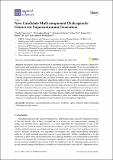| dc.contributor.author | Goncalves, Claudia | |
| dc.contributor.author | Kang, Myungkoo | |
| dc.contributor.author | Sohn, Byoung-Uk | |
| dc.contributor.author | Tan, Dawn T. H. | |
| dc.contributor.author | Richardson, Kathleen | |
| dc.contributor.author | Tan, Dawn | |
| dc.contributor.author | Yin, Gufan | |
| dc.contributor.author | Hu, Juejun | |
| dc.date.accessioned | 2018-11-29T14:42:20Z | |
| dc.date.available | 2018-11-29T14:42:20Z | |
| dc.date.issued | 2018-10 | |
| dc.date.submitted | 2018-10 | |
| dc.identifier.issn | 2076-3417 | |
| dc.identifier.uri | http://hdl.handle.net/1721.1/119359 | |
| dc.description.abstract | Broadband supercontinuum (SC) generation requires host material attributes defined by both optical and physical properties and the material’s manufacturability. We review and define the trade-offs in these attributes as applied to fiber or planar film applications based on homogeneous glass property data, and provide a series of examples of how one might optimize such attributes through material compositional and morphology design. As an example, we highlight the role of varying composition, microstructure, and linear/nonlinear optical properties, such as transmittance, refractive index, and the multiphoton absorption coefficient, for a series of novel multicomponent chalcogenide glasses within a model GeSe<sub>2</sub>-As<sub>2</sub>Se<sub>3</sub>-PbSe (GAP-Se) system. We report key optical property variation as a function of composition and form, and discuss how such glasses, suitable for both fiber and planar film processing, could lend themselves as candidates for use in SC generation. We demonstrate the impact of starting glass composition and morphology and illustrate how tailoring composition and form (bulk versus film) leads to significant variation in linear, nonlinear, and dispersive optical property behavior within this system that enables design options that are attractive to optimization of desirable SC performance, based on optical composites. Keywords: photonics; supercontinuum generation; nonlinear optics; infrared optical materials; chalcogenide glass science | en_US |
| dc.description.sponsorship | National Science Foundation (U.S.) (Grant 1506605) | en_US |
| dc.publisher | Multidisciplinary Digital Publishing Institute (MDPI) | en_US |
| dc.relation.isversionof | http://dx.doi.org/10.3390/app8112082 | en_US |
| dc.rights | Creative Commons Attribution | en_US |
| dc.rights.uri | http://creativecommons.org/licenses/by/4.0/ | en_US |
| dc.source | Multidisciplinary Digital Publishing Institute | en_US |
| dc.title | New Candidate Multicomponent Chalcogenide Glasses for Supercontinuum Generation | en_US |
| dc.type | Article | en_US |
| dc.identifier.citation | Goncalves, Claudia et al. "New Candidate Multicomponent Chalcogenide Glasses for Supercontinuum Generation." Applied Sciences 8, 11 (October 2018): 2082 © 2018 The Author(s) | en_US |
| dc.contributor.department | Massachusetts Institute of Technology. Department of Materials Science and Engineering | en_US |
| dc.contributor.mitauthor | Yin, Gufan | |
| dc.contributor.mitauthor | Hu, Juejun | |
| dc.relation.journal | Applied Sciences | en_US |
| dc.eprint.version | Final published version | en_US |
| dc.type.uri | http://purl.org/eprint/type/JournalArticle | en_US |
| eprint.status | http://purl.org/eprint/status/PeerReviewed | en_US |
| dc.date.updated | 2018-11-22T14:25:34Z | |
| dspace.orderedauthors | Goncalves, Claudia; Kang, Myungkoo; Sohn, Byoung-Uk; Yin, Gufan; Hu, Juejun; Tan, Dawn; Richardson, Kathleen | en_US |
| dspace.embargo.terms | N | en_US |
| dc.identifier.orcid | https://orcid.org/0000-0002-6329-4777 | |
| dc.identifier.orcid | https://orcid.org/0000-0002-7233-3918 | |
| mit.license | PUBLISHER_CC | en_US |
